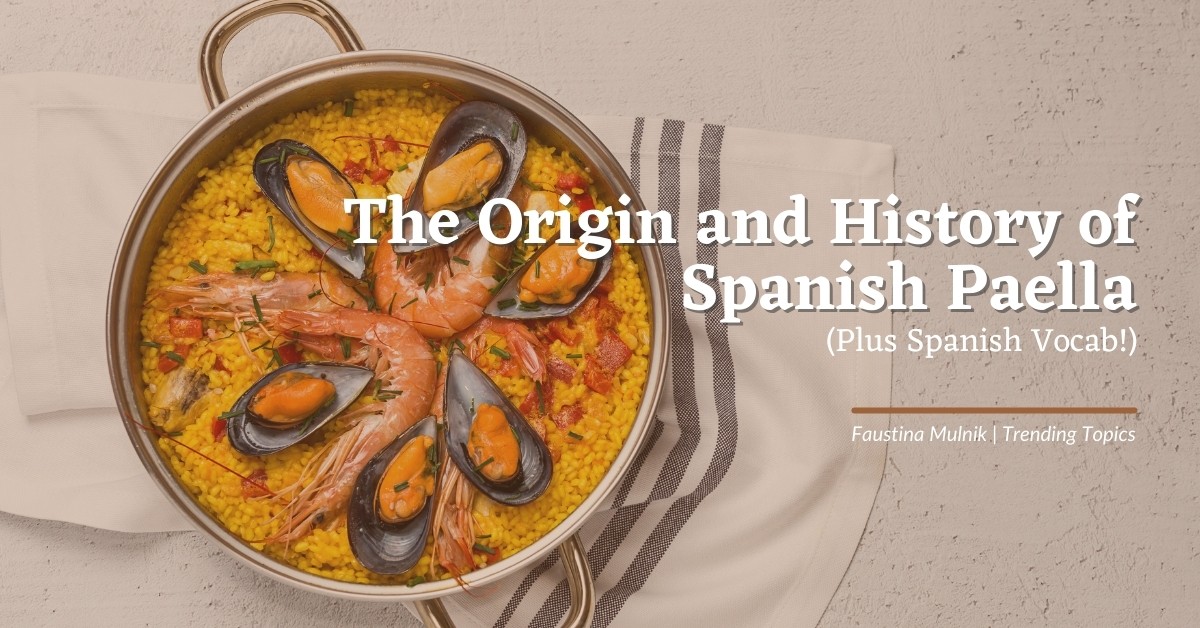
The Origin and History of Spanish Paella (Plus Spanish Vocab!)
You don’t have to be from Spain to know about its infamous paella. People from all over the globe associate this country with this warm versatile food. But how did one dish manage to dominate Spanish cuisine?
What is Paella
Spanish paella is sort of like a kitchen sink cookie: it’s made up from leftover odds and ends. The key ingredient is rice, but other than that paella can come in all sorts of flavors. It usually has a mixture of rice, veggies, seasoning, and some sort of meat or seafood. Paella’s variety allows it to cater to different tastes and regions.
How Paella Got Its Name
Paella isn’t just the name of a food! It’s also the name for the wide, shallow pan it is traditionally cooked in.
It’s incredibly important to make sure your paella is cooked in one of these pans or else Spaniards will argue you didn’t actually make paella! Because this recipe is always made in these types of pans, the name paella is now used for both the recipe and the pan.
Paella is said to have originated in Valencia, one of Spain’s autonomous communities. Like several regions in Spain, Valencia has its own language. Here, they speak Valencian, which is a sort of mixture of Spanish and French. This language is likely where paella gets its name since its word for “pan” is paella. In French, frying pan is “paelle” and likely where the Valencian word came from.
Learn more: Explore the 17 Spanish Regions: Maps, Flags, and GDP
Its Origin
Paella wasn’t always known as Spain’s national dish. It started out with humble origins in the Valencian country.
Hungry farmworkers supposedly invented the dish when they combined whatever they had on hand to create the first paella. The paella’s ingredients depended on what was around them.
These farmers took the rice that they grew and added rabbit, snails, vegetables, and whatever else they could find into a large pan. They often gathered the food and cooked it in the middle of the field—talk about fresh ingredients!
The dish took on a new look in the 1800s as people besides the farmers became aware of it. Paella spread beyond the fields and gained popularity. Rabbits and snails were replaced with more expensive chicken. A new paella was born.
But the paella didn’t stop there!
As paella spread along Spain’s coasts, fresh seafood was added, creating yet again another version of this versatile dish.

Paella’s History
Spanish Paella’s history goes back hundreds of years.
This dish wouldn’t exist without the Romans first bringing irrigation to Spain. This enabled farming to become a lot easier. When the Moors later brought rice over, fields flourished with this crop. The Moors also brought over saffron which is another essential paella ingredient that gives it its yellow color.
Spanish uses many Arabic words, including those for rice and saffron. It’s possible that paella’s name also comes from Arabic since the Granadan Arabic word for leftovers is bagiyyah.
The idea of adding leftovers to rice also comes from the Moors. Arabic servants of royal courts would take home table leftovers and add them into a pan of rice. Paella is arguably one of many Arabic rice dishes.
How Paella Became the National Dish of Spain
How did this dish of humble origins go on to become the symbol of an entire country?
During his dictatorship of Spain, General Francisco Franco wanted to create a nationalist and uniform Spanish identity. He picked his favorite dance, language, and, yes, even dish to become symbols of Spain.
His reign lasted from 1936 to 1975 and his new symbols spread through the country. People embraced Spanish paella and the other new Spanish symbols out of fear for Franco’s wrath.
These changes had steep consequences. Franco sought to eliminate parts of Spanish culture that did not fit into his nationalist identity. Regional languages and cultures became dangerous to practice and came close to dying out.
Today, regional languages and cultures are better protected, but Franco’s symbols still remain popular throughout Spain.
The 5 Most Common Types of Paella
There are over a dozen ways to create Spanish paella! It’s a versatile dish that has taken on many different styles and tastes over the years. Here are the 5 most common types of paella, but it’s certainly not all of them!
1. Valencian Paella
Valencian paella, or paella Valenciana, is the “original” form of paella. Just like the farmers created it back in the field, this paella is filled with ingredients like rice, green vegetables, rabbit, duck, snails, and seasoning.
Be careful with your terminology when requesting paella! Valencians take their paella very seriously since it’s their traditional dish. They find it offensive if you ask for chicken in Valencian paella, since this original version of the dish does not have any. If you’re looking for chicken or seafood, you’ll want to order a different type of paella.
2. Seafood Paella
Seafood paella is, of course, filled with various seafoods rather than meat. Also known as paella de marisco, this dish could have prawns, mussels, clams, or lobster in addition to its base of rice and seasoning.
This paella is a little bit more “soupy” than the rest since the seafood adds extra liquid. It’s even been given the nickname arroz caldoso, or “soupy rice.” However, some argue this actually adds more flavor to the dish!
3. Mixed Paella
Just like the name suggests, this type of paella is a mixture of the others. This paella mixta is one of the most popular types of paella. It can have both meat and seafood along with the typical vegetables and rice.
4. Vegetarian Paella
This paella is perfect for herbivores! Rather than having meat or seafood, this version relies on a versatile selection of vegetables, beans, and rice. If you’re a vegetarian abroad in Spain, be sure to ask for paella vegetariana!
5. Black Paella
This dish is probably the most adventurous of all the versions! It’s called black paella, or paella negra, because of its dark color. The black color actually comes from squid ink! This gives the paella a unique taste and makes it the perfect recipe for the daring traveler!
Ingredients: Spanish Vocabulary
Like all good recipes, paella’s rich flavor comes from its fresh ingredients. You’ll never get confused again looking at a Spanish paella menu with these vocabulary words in your Spanish tool belt!
Rice — El arroz
Saffron — El azafrán
Chicken — El pollo
Fish — El pescado
Clams — Las almejas
Olive Oil — El aceite de oliva
Onion — La cebolla
Bell Pepper — El pimiento morrón
Tomatoes — El tomate
Vegetables — Las verduras
Garlic — El ajo
Lemon — El limón
Parsley — El perejil
Paprika — El pimentón
Snails — Los caracoles
Rabbit — El conejo
Beans — Los frijoles
Squid Ink — La tinta de calamar
Have You Ever Tried Paella?
Everyone should try this historic, mouth-watering dish at least once. What type of Spanish paella do you want to try? Would you prefer to taste the familiar paella mixta or are you adventurous enough to take on paella negra? Tell us your thoughts in the comments below!

Want more free Spanish fun content? Check these out!
- Are Bilingual Children More Likely to Experience a Speech or Language Delay?
- Top 10 Places to Visit in Guatemala City, Guatemala
- Learn About Hispanic History: Were Hispanics Slaves?
- ‘How Much Is It?’ in Spanish: A Guide to Travel and Shopping
- Familial Bonds: Expressing ‘Sister-in-Law’ in Spanish and Family Vocabulary
- 100 Easy Spanish Words for True Beginners
- Earth Day Projects for Kids + Spanish Earth Day Vocabulary
- Celebrating Culture and Joy: The Magic of Carnival in Spanish-Speaking Countries
- How to Talk About the Temperature in Spanish: Fahrenheit, Celcius, and Descriptions - February 8, 2024
- How To Use the Spanish Verb ‘Parecer’ - February 12, 2023
- How To Write Dates in Spanish - January 28, 2023




